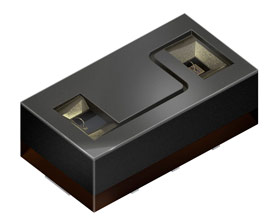- News
25 April 2013
Osram unveils low-power-consumption proximity and ambient light sensor to control smartphone display backlighting and touch functions
Osram Opto Semiconductors GmbH of Regensburg, Germany has expanded its portfolio of proximity and ambient light sensors with a new powerful version with low power consumption. The compact SFH 7776 digital sensor registers the ambient brightness – even behind dark smartphone covers – and prevents unintentional responses from the touch screen during telephone calls. This makes it easier for smartphone designers to control the backlighting and touch functions of displays.
The digital SFH 7776 sensor contains an infrared LED (IRED) and two detectors to perform two different functions. It registers the ambient brightness in order to control the display backlighting so that it can always be easily read but consumes as little power as possible. It also deactivates the touch function on the display as soon as you hold the phone up to your ear during a phone call. To do this, the sensor emits infrared light that is reflected by approaching objects, such as your ear.
 Picture: The SFH 7776 combination proximity and ambient light sensor.
Picture: The SFH 7776 combination proximity and ambient light sensor.
With a working range of up to 16cm and small size (4mm x 2.1mm), the SFH 7776 has been designed specifically for use in smartphones and other mobile devices. Due to the sensitivity of the detector, the sensor does not need lenses to collect the emitted infrared light. Its height is hence just 1.35mm. With its black casing, the sensor is virtually invisible – even behind transparent phone covers. Its low power consumption is also a key factor for mobile devices – in standby mode, it draws only 0.8A of current.
Behind dark covers
With a detection limit of 0.002 lux (lx), the highly sensitive SFH 7776 can even be used behind dark casing panels. Designers can place the sensor anywhere and do not need a special translucent window. “The SFH 777x series gives our customers a complete family of multifunctional sensors for an extremely wide range of phone covers,” says Dirk Sossenheimer, responsible for intelligent sensor applications at Osram Opto. Also, the SFH 7776 is designed so that the ambient light sensor does not react to short-term fluctuations in the brightness of various lamp types caused, for example, by changes in the power supply frequency. This ensures that the display backlighting remains constant.
No crosstalk with proximity sensor
Crosstalk (in which the emitted infrared light is reflected by the smartphone casing directly onto the receiver) is eliminated in the component itself. Designers no longer need to provide separate optical barriers between the IRED and the detector, making it easier to create robust, uncomplicated solutions for different setups, says the firm.
 Picture:
The SFH 7776 detects objects and people as far away as 16cm.
Picture:
The SFH 7776 detects objects and people as far away as 16cm.
Since the SFH 7776 covers the complete working range from 0 to 16mm, it would react even to direct contact (‘zero distance detection’). The touch function of the display is therefore reliably deactivated, even in marginal situations. “Overall, the SFH 7776 overcomes various challenges in terms of proximity and ambient light detection in the component itself, so designers can integrate the product in smartphones relatively easily,” Sossenheimer concludes.



